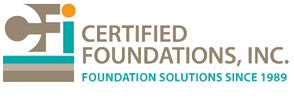An Explanation of Underpinning Methods from CFI – Your Foundation Contractor in Orlando, Jacksonville, Naples, Tallahassee and All Florida Cities
 Many home and business owners know little about underpinning methods before finding out that they’re in need of a foundation repair. In a broad sense, underpinning is any process that increases the strength and stability of an existing foundation, though in a more practical sense it generally refers to those methods that transmit the foundation’s load to more stable soil strata or bedrock. There are many underpinning methods that are commonly used to achieve this, each with various advantages and disadvantages. Certified Foundations, Inc. (CFI) wants to take this opportunity to provide you with some basic information on the commercial and home underpinning methods we offer, so you can better understand how our services can address your foundation issue.
Many home and business owners know little about underpinning methods before finding out that they’re in need of a foundation repair. In a broad sense, underpinning is any process that increases the strength and stability of an existing foundation, though in a more practical sense it generally refers to those methods that transmit the foundation’s load to more stable soil strata or bedrock. There are many underpinning methods that are commonly used to achieve this, each with various advantages and disadvantages. Certified Foundations, Inc. (CFI) wants to take this opportunity to provide you with some basic information on the commercial and home underpinning methods we offer, so you can better understand how our services can address your foundation issue.
Helical piles – Installing helical piles is one of the most common methods of underpinning foundations, due to the relatively low costs and ease with which they can be installed. Each pile consists of a pipe containing one or more flights of helical plates attached, commonly made from a durable metal such as steel. As the piles are turned, the helical plates auger into the ground like a screw does into wood. The load bearing capacity of each pile can be calculated by the amount of torque required to turn it. When piles are driven to the right depth they are attached to the foundation using brackets, transmitting the weight down to the more stable strata.
Resistance pier jacking – In this process, brackets are attached to the home foundation along with hydraulic systems that force steel pipes into the ground, using the building’s weight as a reaction load. Once the piles are driven into a stable soil strata or bedrock that can support the structure’s weight, the hydraulic systems will begin to lift the foundation instead. This can lift foundations back to a level pitch, closing cracks that may have developed due to sinking. This process is also relatively cost effective compared to many other underpinning methods, and allows for precise leveling of structures.
While effective, these underpinning methods may not always be enough to completely solve your foundation issue. The relatively small diameter of helical piles and resistance piers used in these underpinning methods means that they rely on the surrounding soil for lateral stability. Voids, liquefaction and other geological issues can cause piles to buckle and fail if left untreated. This is why we are equipped and trained to perform a variety of soil stabilization methods as well as underpinning. CFI also uses some of the highest quality underpinning products on the market, A.B. Chance piles and Atlas piers, to ensure lasting results. In fact, we are able to provide a 30-year warranty on all our underpinning products as a member of the Chance Alliance Network.
To learn more about the underpinning methods employed by CFI, contact us today.


